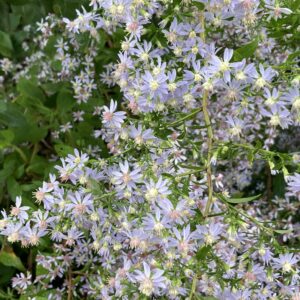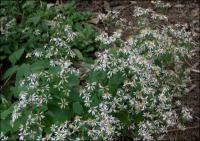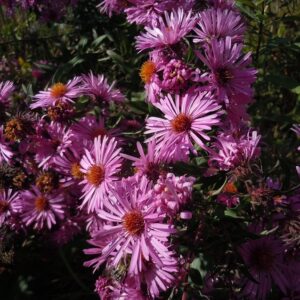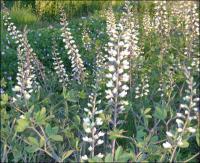Wisconsin Native
Showing 17–24 of 107 results
-
Aster cordifolius syn. Symphyotrichum cordifolium Blue wood aster Z 3-8
Heart-shaped foliage smothered with blue daisies from late summer into fall, perfect companion for anemones.
Heart-shaped foliage smothered with blue daisies from late summer into fall, perfect companion for anemones.
Size: 2-3' x 2-3'
Care: Sun to full shade in moist well-drained to dry soil
Native: Canada to Florida, west to Oklahoma, Wisconsin native
Wildlife Value: Aster species are nectar sources for many butterflies – Checkered white and Checkered skippers, Spring azure, Pearl crescent, Buckeye, Painted lady, Fiery skipper, Sachem, Sleepy orange, Silver-spotted skipper and Monarch.Aster means star, referring to the flower’s form. Winnebago used this in the sweat bath. 1st described by French botanist Jacques Philippe Cornut in 1635. Likely collected and transported from Canada to France by Samuel de Champlain. Grown in Jardin du Roi in Paris.
-
Aster divaricatus syn. Eurybia divaricatus White wood aster Z 4-8
Loose white corymbs blooming from August to October
Loose white corymbs blooming from August to October
Size: 12" x 12" and spreading
Care: part shade to shade in moist well-drained to dry soil.
Native: East No. America Quebec to Alabama and west to Ohio
Wildlife Value: Aster species are nectar sources for many butterflies – Checkered white and Checkered skippers, Spring azure, Pearl crescent, Buckeye, Painted lady, Fiery skipper, Sachem, Sleepy orange, Silver-spotted skipper and Monarch.
Awards: Recipient Great Plant Pick Award from Elizabeth Carey Miller Botanical Garden.Aster means star, referring to the flower’s form. Collected by Philadelphia nurseryman John Bartram before 1776. Sold in America’s 1st plant catalog, Bartram’s Broadside, 1783. Gertrude Jekyll, mother of the perennial border, often used Aster divaricatus in combination with Bergenia.
-
Aster novae angliae syn. Symphyotrichum New England Aster Z 4-8
August – October, classic violet, pink or magenta daisies
August – October, classic violet, pink or magenta daisies
Size: 3-4' x 24"
Care: Full sun dry to moist soil. Heat and drought tolerant.
Native: Vt to Alabama, west to N. M., Wisconsin native
Wildlife Value: Nectar source for many butterflies - Checkered white and Checkered skippers, Spring azure, Pearl crescent, Buckeye, Painted lady, Fiery skip butterfly, Sachem, Sleepy orange, Silver-spotted skipper and Monarch. Host for caterpillars Wavy-lined emerald moth.Aster means star, referring to the flower’s form. For the Cherokee New England aster tea cured fevers and diarrhea. Roots remedied pain and inflammation of the nose and throat. Introduced to garden cultivation by John Tradescant the Younger (1608-1662) in 1637 when he sent it to England where upon borders of New England aster became common. Washington grew New England Aster at Mount Vernon.
-
Aster oblongifolius syn. Symphyotrichum oblongifolium, Aromatic aster Z 3-8
Purplish blue daisies with yellow centers blooming in September to November, Good, bushy mound shape. Called “aromatic” for the fragrance of its leaves.
Purplish blue daisies with yellow centers blooming in September to November, Good, bushy mound shape. Called “aromatic” for the fragrance of its leaves.
Size: 1-2’ x 1-3’
Care: sun to shade in well-drained to moist well-drained soil
Native: Pennsylvania to No. Carolina west to Wyoming & Texas, Wisconsin native
Wildlife Value: Bees collect pollen and nectar from it. Medium sized butterflies collect its nectar. Its leaves support Silvery checkerspot and some moth caterpillars, Deer resistant.
Size: Navajo made a decoction of this to protect against witches.Aster means star, referring to the flower’s form. Navajo made a decoction of this to protect against witches.
Meriwether Lewis collected this on the Expedition September 21, 1804, the day after nearly being swept away while Lewis and the Corps of discovery slept on an eroding sandbar, near the Big Bend of the Missouri River in South Dakota. 1st published description by planthunter Thomas Nuttall (1786-1879) in 1818..
-
Baptisia australis syn. Saphora australis False Indigo Z 3-9
Foot-long spires of indigo blue pea-like flowers (it’s a legume) in June followed by ornamental black seed pods on this perennial that looks like a shrub. Internationally known garden designer Piet Oudolf’s 100 “MUST HAVE” plants, Gardens Illustrated 94 (2013).
Foot-long spires of indigo blue pea-like flowers (it’s a legume) in June followed by ornamental black seed pods on this perennial that looks like a shrub. Internationally known garden designer Piet Oudolf’s 100 “MUST HAVE” plants, Gardens Illustrated 94 (2013).
Size: 3' x 3'
Care: Full sun in well-drained soil. Heat and drought tolerant.
Native: Eastern United States, Wisconsin native.
Wildlife Value: Food source for several caterpillars and nectar for a number of butterflies. Deer resistant.
Awards: Received England’s Royal Horticultural Society Award of Merit. Perennial Plant Association Plant of the Year Award, 2010. Missouri Botanic Garden Plant of MeritBaptisia is Greek meaning to dye referring to use of the plant as a substitute for indigo dye. Cherokee used Baptisia australis for a number of illnesses: cease mortification, cure toothaches. Collected by John Bartram (1699-1777) plant explorer and colonial nurseryman by 1748.
-
Baptisia leucantha syn. Baptisia lacteata, Baptisia alba White Wild Indigo, Prairie wild indigo Z 3-9
Towering creamy white flower spikes in May & June followed by dark seed pods.
Towering creamy white flower spikes in May & June followed by dark seed pods.
Size: 3-5' x 2-3'
Care: full sun to part shade in rich well-drained soil.
Native: Wisconsin native – from Minnesota to Texas.
Wildlife Value: food source for several caterpillars and nectar and pollen for a number of butterflies and bees. Deer resistant.Winnebago (HoChunk) mashed cooked root to make a poultice applied to remedy inflammation of the womb. Baptisia is Greek meaning to dye referring to use of Baptisia australis as a substitute for indigo dye. Leucantha means white flowered.
-
Baptisia sphaerocarpa Yellow wild indigo Z 5-8
Spikes of yellow pea-like flowers in spring cover this broad plant - really makes you say “awe” or “oooh” when it blooms. All season resembles a shrub Flowers turn into round seed pods the size of a marble. This is a legume that improves soil fertility by making nitrogen available to the Baptisa and surrounding plants.
Spikes of yellow pea-like flowers in spring cover this broad plant – really makes you say “awe” or “oooh” when it blooms. All season resembles a shrub, flowers turn into round seed pods the size of a marble. This is a legume that improves soil fertility by making nitrogen available to the Baptisa and surrounding plants.
Size: 3’ x 3’
Care: sun to part shade in moist well-drained to dry soil.
Native: Missouri to Mississippi to TX
Wildlife Value: Attracts butterflies. Deer resistant
Awards: Missouri Botanic Garden Plant of Merit.Baptisia is Greek meaning “to dye” referring to use of Baptisia australis as a substitute for indigo dye. Sphaerocarpa means “round seed.” Collected before 1834 by Thomas Nuttall (1786-1859) English planthunter who scoured the US from the Atlantic to the Pacific.
-
Bouteloua curtipendula Sideoats grama Z 4-8
Narrow, blue-green leaves tinged purple or red in fall when golden oat-like seeds hang down one side of each leaf, eye-catching.
Narrow, blue-green leaves tinged purple or red in fall when golden oat-like seeds hang down one side of each leaf, eye-catching.
Size: 2-3' x 1'
Care: Sun in well-drained to moist well-drained soil, drought tolerant
Native: most of US, incl. Wisconsin
Wildlife Value: nesting material for butterflies and bees; larval host for some Skipper butterflies,
Awards: state grass of TexasKiowa natives who had killed an enemy in battle with a lance wore this. Collected and described by French planthunter André Michaux (1786-1802) who scoured Eastern North America west to the Mississippi over 11 years.








